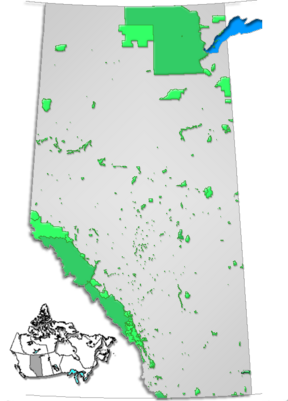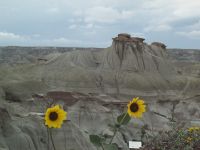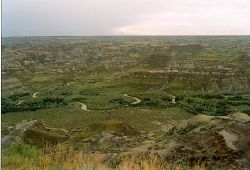Dinosaur Provincial Park
| Dinosaur Provincial Park | |
|---|---|
| IUCN Category III (Natural Monument) | |
| | |
| Location: | Alberta, Canada |
| Nearest city: | Brooks |
| Area: | 73.29km² |
| Established: | 1955 |
| Governing body: | Alberta Tourism, Parks and Recreation |
Dinosaur Provincial Park is situated in the valley of the Red Deer River, which is noted for its striking badlands topography. The park is well known for being one of the greatest dinosaur fossil beds in the world. Thirty-nine dinosaur species have been discovered at the park, and more than 500 specimens have been removed and exhibited in museums across the globe. Its significance justified it becoming a World Heritage Site in 1979.
The park is located about two hours' drive east of Calgary, Alberta, Canada or 30 miles (48 km) northeast of Brooks.
Nature
The park boasts a very complex ecosystem including three communities: prairie grasslands, badlands, and riverside cottonwoods. Its ecosystem is surrounded by prairies but is unique. Choruses of coyotes are common at dusk, as are the calls of nighthawks. Cottontail rabbits, mule deer, and pronghorn can all be seen in the park; the prairie rattlesnake, bull snake, and the red-sided garter snake are present as well. Black widow spiders and scorpions also call this park home. Curlews and Canada geese are among the 165 bird species that can be seen in the spring and summer. Some of the most northern species of cactus, including Opuntia (prickly pear) and Pediocactus (pincushion) can be observed in full bloom during the latter half of June.
he Grassland Natural Region is characterized by cold winters, warm summers, high winds and low precipitation. The region is a flat to gently rolling plain with a few major hill systems, punctuated by exposed bedrock, carved sandstone cliffs, ancient boulders and other reminders of the last ice age. Where wind and water have carved the bedrock, unique landscapes known as badlands exist. Plants have adapted to the severe moisture shortage of mid-to-late summer.
Dinosaur Provincial Park is located in the Dry Mixedgrass Sub-region of the Grassland Natural Region. This is the warmest and driest sub-region in Alberta. Permanent streams are relatively rare, though the ones that do exist are deeply carved into the bedrock in some places. This has exposed Cretaceous shales and sandstones, creating extensive badlands in some areas.
Top of Page
The Badlands Great rivers that flowed here 75 million years ago left sand and mud deposits that make up the valley walls, hills and hoodoos of modern-day Dinosaur Provincial Park. At the end of the last ice age (about 13,000 years ago) water from the melting ice carved the valley through which the Red Deer River now flows. Today, water from prairie creeks and run-off continues to sculpt the layers of these badlands, the largest in Canada. The result is an eerie landscape that looks like another world!
Dinosaurs Seventy-five million years ago, the landscape was very different. The climate was subtropical, with lush forests covering a coastal plain. Rivers flowed east, across the plain into a warm inland sea. The low swampy country was home to a variety of animals, including dinosaurs. The conditions were also perfect for the preservation of their bones as fossils. Today, after a century of excavations over 150 complete dinosaur skeletons have been discovered, as well as disorganized concentrations of bones called 'bone beds.'
Birds, Animals & Flowers
FlowerThe three distinct habitats of Dinosaur Provincial Park support many animals and plants. Cottonwood and willow trees share the moist riverbanks with saskatoon, rose and buffalo-berry bushes. Cacti, greasewood and many species of sage survive in the hot dry badlands. Prairie grasses dominate the landscape above the valley rim. Many different animals make their home here. Watch for mule and white-tailed deer as well as cottontail rabbits. Coyotes may be seen but are more often heard. Look for pronghorn antelope on the vast rolling prairie. Birdwatching is excellent in May and June in the cottonwood groves where warblers, woodpeckers and waterfowl are easy to observe. Away from the river's edge scan the sky for golden eagles, prairie falcons, and mountain bluebirds.
Geology
A badlands (also badland) is a type of arid terrain where softer sedimentary rocks and clay-rich soils have been extensively eroded by wind and water. It can resemble malpaís, a terrain of volcanic rocks. Canyons, ravines, gullies, hoodoos, and other such geological forms are common in badlands. Badlands often have a spectacular color display that alternates from dark black/blue coal stria to bright clays to red scoria (a type of volcanic rock).
The term badlands is apt as they contain steep slopes, loose dry soil, slick clay, and deep sand, all of which impede travel and other uses. Badlands form in arid regions with infrequent but intense rain-showers, sparse vegetation, and soft sediments: a recipe for massive erosion.
Some of the most famous fossil beds are found in badlands, where erosion rapidly exposes the sedimentary layers and the scant cover of vegetation makes surveying and fossil hunting relatively easy.
The sediments of Dinosaur Provincial Park span 2.8 million years and three formations: the terrestrial Oldman Formation at the base of the strata, the terrestrial Dinosaur Park Formation above, and the marine Bearpaw at the top. The Dinosaur Park Formation, which contains most of the fossils from articulated skeletons, was primarily laid down by large meandering rivers in very warm temperate coastal lowlands along the western margin of the Western Interior Seaway. The formation dates to the Late Campanian, about 75 million years ago. The Dinosaur Park Formation spans about 1 million years.
A hoodoo is a tall thin spire of rock that protrudes from the bottom of an arid drainage basin or badland. Hoodoos are composed of soft sedimentary rock and are topped by a piece of harder, less easily eroded stone that protects the column from the elements. Hoodoos range in size from that of an average human to heights exceeding a 10-story building. Hoodoo shapes are affected by the erosional patterns of alternating hard and softer rock layers. Minerals deposited within different rock types cause hoodoos to have different colors throughout their height.
Paleontology
Dinosaur Provincial Park preserves an extraordinarily diverse group of freshwater vertebrates. Fish include sharks, rays (such as the durophage Myledaphus), paddlefish, bowfins, gars, and teleosts. Amphibians include frogs, salamanders, and the extinct albanerpetontids. Reptiles include lizards (such as the large monitor Paleosaniwa), a wide range of turtles, crocodilians, and the fish-eating Champsosaurus. Mammals such as shrews, marsupials, and squirrel-like rodents are also represented, although usually only by their fossilized teeth, rather than bones.
Mega-plant fossils are rare in the park, but pollen grains and spores collected suggest that these Campanian forests contained sycamore, magnolia, and bald cypress trees, along with Metasequoia.
The dinosaurs of the park are astonishingly diverse. They include:
Ceratopsia
- Leptoceratops sp.
- Centrosaurus apertus,C. brinkmani
- Styracosaurus albertensis
- Pachyrhinosaurus
- Chasmosaurus belli, C. russeli, C. irvinensis
Hadrosauridae
- Corythosaurus casuarius
- Gryposaurus notabilis, G. incurvimanus
- Lambeosaurus lambei,L. magnicristatus
- Prosaurolophus
- Parasaurolophus walkeri
Ankylosauria
- Panoplosaurus
- Edmontonia
- Euoplocephalus
Hypsilophodontidae
- Orodromeus
Pachycephalosauria
- Stegoceras
Tyrannosauridae
- Daspletosaurus sp.
- Gorgosaurus libratus
Ornithomimidae
- Ornithomimus
- Struthiomimus
- new ornithomimid species A
- Chirostenotes pergracilis
- Chirostenotes elegans
- Chirostenotes collinsi
Dromaeosauridae
- Dromaeosaurus
- Saurornitholestes
- ?new dromaeosaur species A
- ?new dromaeosaur species B
Troodontidae
- Troodon
- new troodontid species A
Classification Uncertain
- Ricardoestesia gilmorei
Birds such as Hesperornithiformes were present, as well as giant Pterosauria related to Quetzalcoatlus. Stagodont marsupials, placentals, and multituberculates scurried underfoot.
History
In 1884, Joseph Tyrell, an assistant to a surveyor sent to the area, found bones later identified as an Albertosaurus. Four years later, the Geological Survey of Canada went Thomas Weston as its fossil collector. Most of his discoveries were in the area known as Dead Lodge Canyon, now part of the park. Another collector, Lawrence Lamb, was sent in 1897. As word spread, other collectors arrived.
Established on June 27, 1955, as part of Alberta's 50th Jubilee Year with the goal of protecting the fossil bone beds, the park's first warden was Roy Fowler, a farmer and amateur fossil hunter.
Until 1985 discoveries made in the park had to be shipped to museums throughout the world for scientific analysis and display, including the Royal Ontario Museum in Toronto, the Canadian Museum of Nature in Ottawa, and the American Museum of Natural History in New York. This changed with the opening of the Royal Tyrrell Museum of Palaeontology 100 kilometers upstream in Midland Provincial Park near Drumheller.
World Heritage Site
The park was established as a UNESCO World Heritage Site on October 26, 1979, both for its nationally significant badlands and riverside habitats, and for the international importance of the fossils found here.
Tourism
About 70 percent of the park is a Natural Preserve, which has restricted access for resource protection and public safety reasons. Entry is only via guided programs. Since these events have limited capacity (17-35 spaces) and demand is increasing every year, visitors are urged to allow two days in case their first choice of tours is sold out. Tour reservations are available and are strongly recommended. Reservations are also recommended for the 125-site campground in July and August.
External links
Credits
New World Encyclopedia writers and editors rewrote and completed the Wikipedia article in accordance with New World Encyclopedia standards. This article abides by terms of the Creative Commons CC-by-sa 3.0 License (CC-by-sa), which may be used and disseminated with proper attribution. Credit is due under the terms of this license that can reference both the New World Encyclopedia contributors and the selfless volunteer contributors of the Wikimedia Foundation. To cite this article click here for a list of acceptable citing formats.The history of earlier contributions by wikipedians is accessible to researchers here:
The history of this article since it was imported to New World Encyclopedia:
Note: Some restrictions may apply to use of individual images which are separately licensed.


